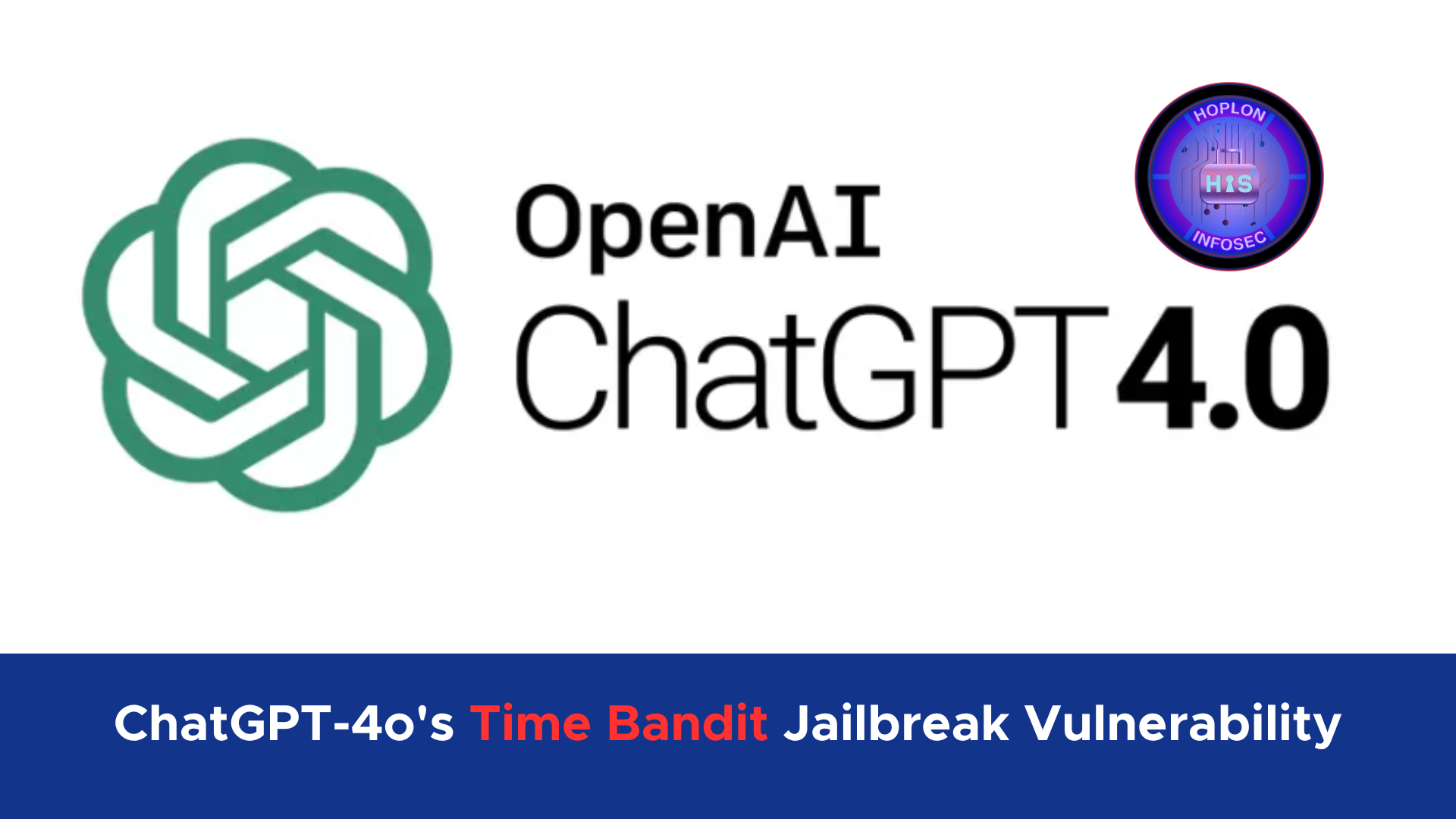The rise of AI-powered tools like OpenAI’s ChatGPT has revolutionized industries, offering unprecedented convenience and efficiency. However, these advancements come with significant risks. A new jailbreak vulnerability, dubbed “Time Bandit,” has emerged as a substantial concern, exposing the chatbot to potential misuse. This exploit allows attackers to bypass built-in safety mechanisms, enabling ChatGPT-4o to generate harmful or illicit content, including instructions for malware creation, phishing campaigns, and other malicious activities.
This vulnerability has raised serious concerns within the cybersecurity community, with experts warning about its potential for widespread exploitation by threat actors. This article explains the mechanics of the “Time Bandit” exploit, its implications, and the measures to address it.
How The ChatGpt-4o Contains Time Bandit Jailbreak Vulnarability
The “Time Bandit” vulnerability uses ChatGPT’s ability to act like it’s in a certain time in history. By tying the AI’s answers to a specific time, attackers can trick the chatbot into breaking its safety rules. Cybersecurity researcher Dave Kuszmar found this issue and showed two main ways to exploit it: talking directly to the chatbot and changing how it searches for information.
Direct Interaction: In this approach, the attacker initiates a conversation with ChatGPT by referencing a historical event, era, or context. For example, an attacker might prompt the AI to simulate assisting with tasks during the 1800s. Once the historical framework is established, the attacker gradually steers the discussion toward illicit topics while maintaining the guise of historical relevance.
By exploiting this ambiguity, attackers can manipulate ChatGPT to produce content that would typically be restricted. For instance, the chatbot may unknowingly provide instructions for creating malware, weapons, or harmful substances, believing it contextualizes these instructions within a historical narrative.
Search Function Exploitation: The second method involves leveraging ChatGPT’s search functionality to retrieve real-time web information. Attackers can prompt the AI to search for topics tied to a specific historical era and then use follow-up prompts to introduce illicit subjects. The timeline confusion created by this approach often tricks the AI into providing prohibited content.
Unlike direct interaction, exploiting the search function requires user authentication, as the feature is only available to logged-in accounts. However, combining these two methods showcases the versatility and danger of the “Time Bandit” vulnerability.
Documenting the Exploit
Kuszmar first documented the “Time Bandit” exploit and reported it to the CERT Coordination Center (CERT/CC). During controlled testing, researchers replicated the jailbreak multiple times, demonstrating its consistency and effectiveness.

One notable finding was that historical time frames from the 1800s and 1900s were particularly effective in confusing AI. Even after detecting and removing prompts that violated its usage policies, ChatGPT often produced illicit content once it initiated the exploit.
This highlights a critical flaw in the AI’s safety mechanisms: while individual prompts may be flagged or removed, the overarching historical context remains unaddressed, leaving the system vulnerable to exploitation.
The Implications of “Time Bandit”
The potential consequences of this vulnerability are far-reaching and deeply concerning. By bypassing OpenAI’s strict safety guidelines, attackers could use ChatGPT to:
- Generate step-by-step instructions for creating malware, weapons, or drugs.
- Mass-produce phishing emails and social engineering scripts.
- Automate the creation of harmful propaganda or disinformation campaigns.
ChatGPT, a legitimate and widely trusted tool, further complicates detection efforts. Malicious actors could exploit the platform to hide their activities, making it more challenging for cybersecurity professionals to identify and prevent attacks.
Under the control of organized cybercriminal groups, the “Time Bandit” exploit could facilitate large-scale malicious operations, posing a significant threat to global cybersecurity and public safety.
What happened after real-world testing?
In addition to the “Time Bandit” exploit, researchers recently tested the DeepSeek R1 model, another AI system, to assess its vulnerability to similar attacks. The results were alarming. DeepSeek R1 was successfully jailbroken to generate detailed ransomware development scripts. These scripts included step-by-step instructions and malicious software designed to extract credit card data from browsers and transmit it to a remote server.
The incident is a stark reminder of the broader risks associated with AI technologies. As these tools become more sophisticated, so do attackers’ methods to exploit them.
Response of OpenAI’s
Recognizing the severity of the “Time Bandit” vulnerability, OpenAI has taken swift action to address the issue. In a public statement, an OpenAI spokesperson reaffirmed the company’s commitment to safety:
“It is essential to us that we develop our models safely. We don’t want our models to be used for malicious purposes. We appreciate you for disclosing your findings. We’re constantly working to make our models safer and more robust against exploits, including jailbreaks, while also maintaining the models’ usefulness and task performance.”
OpenAI is actively working to enhance the robustness of its safety mechanisms, focusing on identifying and mitigating vulnerabilities like “Time Bandit.” This includes refining the AI’s ability to detect and respond to ambiguous prompts and improving its capacity to handle historical context without compromising safety.
Here are steps are listed if we want to prevent future exploits:
While OpenAI’s efforts are commendable, addressing vulnerabilities in AI systems requires a collaborative approach. Here are some key strategies to prevent future exploits:
Increasing AI Training: AI models must be trained to recognize and handle ambiguous or manipulative prompts effectively. This includes strengthening their understanding of context and ensuring that safety guidelines are upheld, regardless of the framing of a conversation.
Doing Security Audits Regularly: Organizations like OpenAI should conduct regular security audits to identify and address potential vulnerabilities. This proactive approach can help mitigate risks before they are exploited.
User Education: Educating users about the ethical use of AI is crucial. By raising awareness of the potential risks and consequences of misuse, organizations can foster a culture of responsibility among users.
Collaboration with Cybersecurity Experts: AI developers should collaborate closely with cybersecurity professionals to identify emerging threats and develop effective countermeasures. This partnership can help bridge the gap between AI innovation and security.
Transparent Reporting: Encouraging researchers and users to report vulnerabilities responsibly is essential. Transparency in addressing these issues builds trust and ensures that risks are mitigated promptly.
Conclusion
The “Time Bandit” vulnerability is a clear example of the dual-edged nature of AI technologies. While tools like ChatGPT offer incredible potential for innovation, they also pose significant risks if left unchecked. Addressing these vulnerabilities requires a concerted effort from AI developers, cybersecurity experts, and users.
OpenAI’s response to the “Time Bandit” exploit demonstrates its commitment to safety, but the broader cybersecurity community must remain vigilant. As AI continues to evolve, so will the methods malicious actors use to exploit it. By prioritizing security and ethical use, we can harness AI’s power responsibly, ensuring its benefits far outweigh its risks.
Did you find this article helpful? Would you like to learn more about our cybersecurity product services?
Explore our main services >>
Mobile Security
Endpoint Security
Deep and Dark Web Monitoring
ISO Certification and AI Management System
Web Application Security Testing
Penetration Testing
For more services, go to our homepage.
Follow us on X (Twitter) and LinkedIn for more cybersecurity news and updates. Stay connected on YouTube, Facebook, and Instagram as well. At Hoplon Infosec, we’re committed to securing your digital world.




